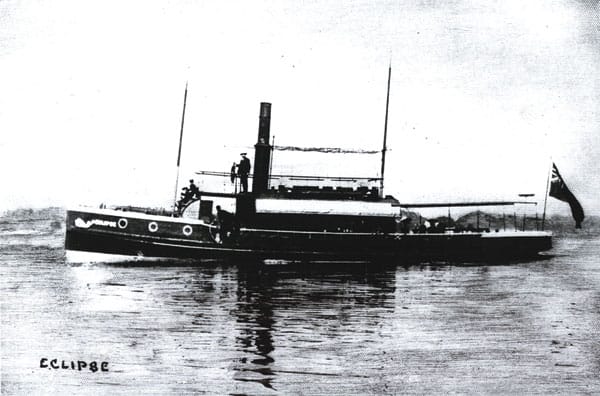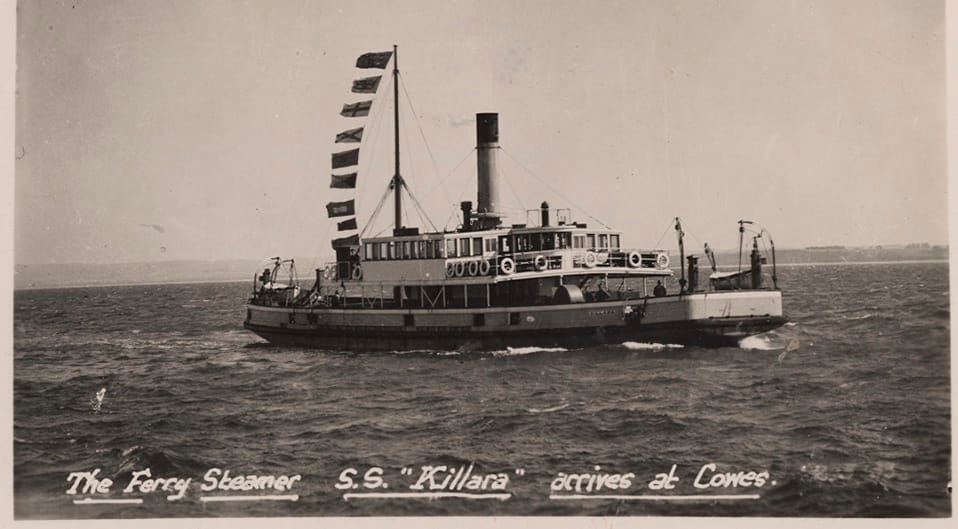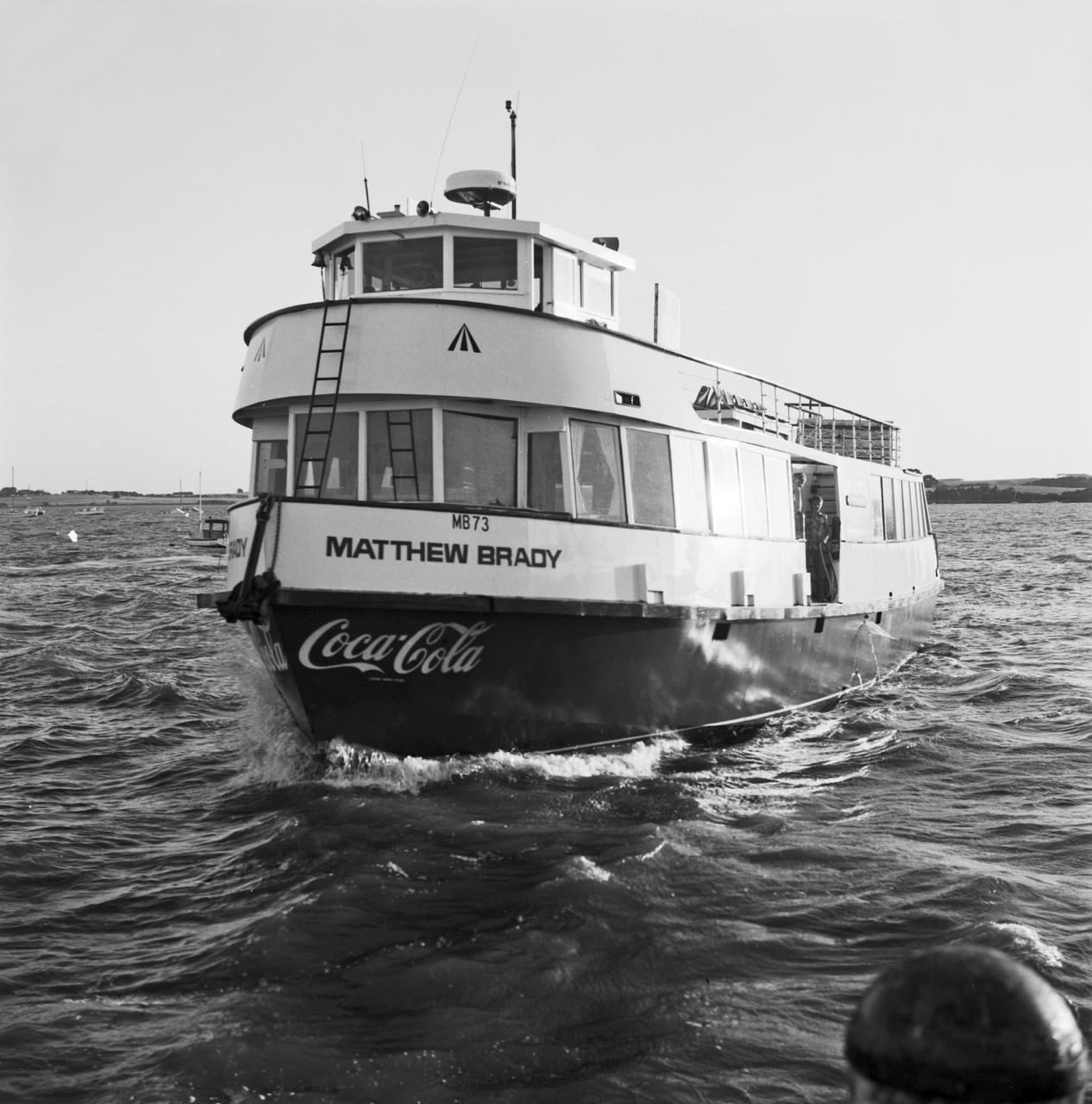The Ferries of Westernport
Phillip Island was first settled in 1868, and since that time until a bridge was built between Newhaven and San Remo in 1940, a series of steam ferries provided the only regular passenger and cargo service on Western Port. The early ferries ran...

Phillip Island was first settled in 1868, and since that time until a bridge was built between Newhaven and San Remo in 1940, a series of steam ferries provided the only regular passenger and cargo service on Western Port.
The early ferries ran between Hastings, Cowes, and Griffiths Point (San Remo). Stony Point replaced Hastings in 1889 with the extension of the rail line to there, and the San Remo service stopped around 1928.
Vehicular ferries ran between Stony Point and Cowes between 1933 and 1948.
The Sarah
The first passenger ferry to serve the island was the Sarah, a 54 foot long paddle steamer, which arrived on the scene in 1872.
She plied between Hastings and Cowes daily, and between Hastings and Griffiths Point (San Remo) on Mondays and Fridays.
The Sarah connected with the Cobb and Co coach at Hastings, which took passengers, mail and cargo on to Melbourne.
After a year on this run the Sarah was withdrawn as there apparently was not enough business. The Eclipse, a steam yacht capable of carrying 60 passengers eventually began the service again in 1876.
Shareholders in the Westernport Steamship Company which ran it included Samuel Amess (owner of Churchill Island) John Cleeland (of Woolamai House) J Roberts (Cobb and Co) and John and Solomon West, Cowes storekeepers.
The vessel was captained by Andrew Lindsay Edgar, whose grand daughter later married into the island’s pioneering Grayden family.
The Company also offered holiday excursions around the island and across to the Flinders jetty for visitors over December and January from both the Cowes and Griffith Point piers.
The Eclipse ran every Monday to Seal Rocks, landing passengers out there when the weather permitted.
It also ran trips to the Nobbies, French Island, Settlement Point, Corinella, Bass and Grantville, and Queensferry, which was a timber town between Corinella and Grantville.
The Vixen
In 1887, the Vixen, a 58 foot 34 tonne wooden vessel, took over the run.
Its master was Captain George Clarke, the father of Jimmy Clarke, who was later to play such an important role in the island’s maritime history.
George was an imposing figure, with his long beard streaming in the wind.
A larger vessel was required with the island’s population growing and San Remo and Grantville districts being opened for selection, and the Genista ferry, from Sydney, was purchased and pressed into service.
The Genista was an eighty tonne 90 foot steamer, and her maiden voyage on Western Port coincided with the extension of the railway line from Hastings to Stony Point.
An advantage of the opening of the rail line was that it shortened the time it took for the ferry journey across the bay.
But it also spelt the end of Cobb and Co.
The Vixen was retained, and continued to run until 1915 as a holiday ferry in busy times, and when the Genista was in dry dock for maintenance.
In 1899, the Westernport Steamship Company was bought by Edmund Smith, who built his home on the future site of Erewhon. Smith died in 1914, and the Genista was sold to AKT Sambell in 1917.
The Vixen came to a sudden end in 1917, when she was being towed to Melbourne for repairs.
The vessel nosedived not far from the Cowes jetty and sank.
Tragedy again struck in 1920 when Captain Claud Phillip Kerr, the Genista’s captain of five years, died of a heart attack at the wheel, aged 40.
First mate Jack Jansson took over as captain for the next six months; and in 1921, Captain Jimmy Clarke, son of the former skipper, took command.
Captain Jimmy Clarke
Captain Clarke was then master in turn of the Genista, and the ferries to follow: the Alvina, the Killara, the Reliance and the Westernport.
Known to all as Jimmy, the publication Phillip Island in Picture and Story records that his initial appointment was considered by the community as a stroke of good fortune, for this thorough sailor was
one of the most capable sea captains in British Mercantile history.
For over a quarter of a century, tens of thousands of carefree holiday makers entrusted themselves to his care without mishap.
Before the advent of the Killara in 1933 (a double ender ferry from which cars drove off and on via a gantry controlled ramp) vehicles were slung aboard by crane, and Captain Clarke had reduced this manoeuvre to a matter of just seconds.
The Killara was preceded by the Alvina, an English yacht famed for its beauty.
It joined the Genista in 1925 on the Cowes Stony Point run.
Both vessels undertook excursions around the island and out to Seal Rocks as well.
Passenger numbers doubled in a three year period, with 25,000 people using the two ferries in 1926, compared to 13,000 in 1923.
A tourism boom was responsible, with the opening of many guest houses including Erehwon, the Continental and Broadwater occurring during this period.
The Narrabeen
Come 1928, an even larger vessel, the Narrabeen arrived in the bay.
The Narrabeen had operated as a Manly cargo ferry, and soon became the main workhorse on the run.
The Alvina was used only in the busy times, and the Genista was converted to carry vehicles as well.
The conversion was short lived as Charles Newman had provided a new option, building a two car punt which crossed the eastern passage between San Remo and Newhaven. AKT Sambell purchased the outfit and replaced it with an even bigger punt, capable of holding six cars at a time the following year.
The punt was towed by a motorboat, and so reliance on a vehicular ferry was greatly reduced.
The Narrabeen’s captain Harold Symonds was quite famous.
He was a decorated World War 1 hero (DSC), given for ramming a German submarine with his merchant ship in the North Atlantic.
The Narrabeen was described in the Phillip Island News publication in later years as the best utility boat that ever crossed Western Port. She always answered demands placed upon her by the cargo, cars and
passengers she carried.
Reliable and economical, this little ship during her four years service to the island covered 10,000 miles without the slightest casualty or mishap, the newspaper recorded.
The Killara



In 1931, just before the opening of the Sydney Harbour bridge , the Sydney vehicular ferries the Killara and the Kedumba were made redundant.
The Kedumba was purchased by AKT Sambell for service on the island, but it sank off Montague Island while under tow.
He then bought the Killara, which was similar, and it arrived safely under its own steam in 1933.
Killara: the first car ferry
The Killara was the first car ferry to be established on Western Port, and was a double ender.
That is, cars could be driven on and off via a ramp controlled by a gantry, from each end.
The Killara’s work load was heavy.
As well as being a popular holiday destination, the island was a motorcycle and car racing destination as well.
On race days, the Alvina was also needed to back up the Killara, all making multiple trips transporting cars, motorbikes , cargo and people to these popular events.
The ferries started early in the morning and worked late into the night on race days.
The biggest day for the Killara was a race day in 1937, when 7,000 return passengers made the crossing.
The book Phillip Island in Picture and Story records that time.
These numbers were over and above the few thousand already on the island for the weekend, to say nothing of all makes, from racers to Rolls Royces transported across the bay as well.
When the last race was over, everyone wanted to get back on the first boat.
They broke down the sturdy barriers on the jetty, and came on board. There was no stopping them. Another authority estimated that 3,000 people had packed on board on a single trip on that day.
Captain Clarke wrote: The old thing just took it in her stride. She was a grand ship.
The Killara, built in 1909 was 146 foot long and had electric light supplied to all parts by a steam driven plant.
Captain Clarke’s favourite vessel, however, was the 194 tonne English built Alvina. She was built at Calshott near Southampton in 1887.
In 1902 she was bought by the Port Phillip Pilot Service and made the voyage to Australia under her own steam and was used until 1925 when bought by AKT Sambell.
She was sold in 1938, and taken to Port Phillip Bay where she was raided by the police. The new owners were charged with illegal gaming offences.
A time of change
Joshua Gliddon, the author of Phillip Island in Picture and Story, noted the following of this particular period of island history.
“Before the advent of the Killara, Phillip Island had gone along quietly since settlement.
“There was not much motor traffic, nor were roads built to carry it.
“But here was a vehicular ferry, a moving bridge, which opened the island to the general traffic of Victoria.
“For better or worse, the island would never be the same again.
“Its history had reached another milestone.”
In 1940 the Phillip Island bridge was opened, which was the beginning of the end for the island’s faithful vehicular ferries.
The Killara continued for another three years; followed by the Reliance for three years after that, and the small car ferry the Mildred (renamed the Westernport) took over in 1946.
The days of the car ferries were over by 1948.
Passenger ferries
From then on a series of passenger ferries plied the route. Cars simply drove over the new bridge.
The first of these were the Estelle Star and Sunrise Star in 1949, brought into service by the Hegarty family, who ran ferries on Sydney Harbour and fishing boats at Eden.
The Sunrise Star was returned to Sydney the following year and replaced by the Eagle Star, which was much bigger.
On one memorable occasion, the Estelle Star was unable to leave Stony Point, because of a huge storm.
Grave fears were held for her safety at the Cowes end, when she failed to arrive.
An attempt to take the Eagle Star out to search for her was fortunately thwarted, when the wind blowing hard from the east proved too strong and it did not have the power to leave the Rhyll jetty.
Both vessels were sold in 1954 to the Crole family.
The Eagle Star was initially used to fish in Bass Strait, and the Estelle Star continued with the passenger run.
In 1959, this situation was reversed.
The Estelle Star became a tuna boat working in Eden, and the Eagle
Star resumed passenger ferry duties between Cowes and Stony Point.
In 1973, the Eagle Star collided with a gas tanker in thick fog on the bay.
Fortunately, no-one was hurt. After repairs, she went back into service, but her days were numbered.
In 1978 the Eagle Star was bought by the newly formed French Island Co-operative.
She sank not far off the Cowes pier on New Year’s eve in 1978, with 160 passengers on board.
All were safely rescued by nearby boats and swimmers who raced to their aid, in the middle of the day during the busy holiday season.
The Eagle Star was successfully raised and after slipping, was taken to Tankerton wharf, only to sink again four months later.
The modern era
The Jeremiah Ryan, a lightly built catamaran was leased by the Co-operative from Tasmanian owners to replace the Eagle Star but was unsuitable for the rough seas at the Cowes jetty and was soon replaced
by the James McCabe.
In June 1979 the Co-operative bought the former old Sydney ferry Ku Ring Gai 11.
It was destroyed by fire with allegations at the time that the fire was lit deliberately.
The Southern Contessa and Matthew Brady followed in quick succession.
The Matthew Brady also burnt to the waterline in 1992, while travelling from Cowes to Rhyll, and was lost forever.
She was replaced by the Commissioner 2 in 1992.
In 1994, San Remo’s John Dickie had the ferry Bay Connections built in South Africa and Fremantle.
John has operated a passenger cruise ferry service ever since, with the Kasey Lee and the recently acquired Brianna Lee.
The newest ferry on the Stony Point to Cowes daily run is the 95-seat vessel MV Naturaliste, introduced by the new operators of the Western Port Ferry Service.





